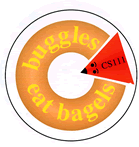
|
Problem Set 6 Due on Tuesday, March 25 by 11pm(Extra Credit due 5pm Saturday, March 29) |

|
Problem Set 6 Due on Tuesday, March 25 by 11pm(Extra Credit due 5pm Saturday, March 29) |
The purpose of this problem set is to give you more experience
with recursion and writing recursive methods that return values.
Task 1 is a pencil-and-paper problem in which you will draw
an invocation tree for a recursive function.
In Task 2, you will use recursion in PictureWorld to generate
a recursively structured quilt.
In Task 3, you will use recursion in BuggleWorld to
implement the elaborate buggle bagel-harvesting ritual.
The code for Tasks 2 and 3 is available in
the ps6_programs folder in the cs111 download
directory on cs.wellesley.edu.
There are also four optional extra credit problems.
In Extra Credit Challenge 1, you can use recursion to
have buggles count the number of bagels in a maze.
In Extra Credit Challenge 2, you can use recursion to
have a turtle draw a diamond pattern and return
the number of diamonds drawn.
In Extra Credit Challenge 3, you can implement
another recursive quilt pattern.
In Extra Credit Challenge 4, you are asked to design
your own recursive buggle/turtle/picture patterns.
The code for the Extra Credit Challenges is available in
the ps6_programs_extra folder in the cs111 download
directory on cs.wellesley.edu.
In order to give you more time to work on the extra credit problems, you can turn in whatever extra credit problems you've done by 5pm Saturday, March 29. The required problems are due at the usual time: 11pm on Tuesday, March 25.
SierpinskiQuilt.java file from Task 2;
HarvestWorld.java file from Task 3.
Save the modified SierpinskiQuilt.java and
HarvestWorld.java files in the ps6_programs
folder. Submit the entire ps6_programs folder to your
drop folder on the cs111 server.
MazeCounterWorld.java file
from Extra Credit Challenge 1 (if you did this problem).
DiamondWorld.java file
from Extra Credit Challenge 2 (if you did this problem) .
TriQuiltWorld.java file
from Extra Credit Challenge 3 (if you did this problem) .
MyBuggleWorld.java,
MyTurtleWorld.java,
and/or MyPictureWorld.java
files from Extra Credit Challenge 4
(if you did this problem).
If you complete any of the extra credit problems,
submit the entire ps6_programs_extra folder to your
drop folder on the cs111 server.
public static int f (int n) {
if (n <= 2) {
return n;
} else {
return n + f(n/2) + f(n/3);
}
}
Draw an invocation tree that summarizes the execution
of the class method invocation f(30).
Each node of the execution tree should have the
form f(arg):result,
where arg is the integer that
is the argument of the invocation of f and
result is the result of the invocation.
Keep in mind that dividing two integers in Java always returns an integer result. For example, (15/2) returns 7, (5/2) returns 2, and (5/3) returns 1.
sierpinskiQuilt(black,cyan,1) |
sierpinskiQuilt(black,cyan,2) |
sierpinskiQuilt(black,cyan,3) |
sierpinskiQuilt(black,cyan,4) |
Tragically, Gilda is an artist with no programming background (where was media arts when she went to college?), so she has to draw all her designs by hand. Since this is extremely error prone and tedious, the Built-a-Quilt company has decided to hire a Java programmer who can express Gilda's designs in Picture World. Impressed by your work on Problem Set 5, Built-a-Quilt hires you to implement the following method:
public Picture sierpinskiQuilt (Color c1, Color c2, int n); Assume that n >= 1. Returns one of Gilda's Sierpinski quilts that is constructed out ofn-level Sierpinski gaskets colored withc1andc2.
When you carefully study Gilda's quilt patterns, you see that there are two auxiliary methods that would greatly simplify your task:
For example:public Picture sierpinski (Color c1, Color c2, int n); Assume that n >= 1. Returns a picture of annlevel sierpinski gasket whose "body" has colorc1and whose "holes" have colorc2. The resulting picture should be a "lower left" triangle -- that is, a triangle two sides of which are the left and bottom edges of the frame in which it is displayed.
sierpinski(black,cyan,1) |
sierpinski(black,cyan,2) |
sierpinski(black,cyan,3) |
sierpinski(black,cyan,4) |
public Picture triangles (Picture tri, int n); Suppose that tri is a "lower left" triangle and n >= 1. Returns a picture whose lower left triangle is filled with tri and whose upper right triangle is an n-level Sierpinski gasket whose "body" is white and whose "holes" are filled with copies of tri.
For example, suppose that rgTri the following lower-left triangle:
rgTri |
Then here are some examples of triangles called with rgTri
and various level numbers:
triangles(rgTri,1) |
triangles(rgTri,2) |
triangles(rgTri,3) |
triangles(rgTri,4) |
sierpinski,
triangles, and sierpinskiQuilt methods in
the file SierpinskiQuilt.java within the SierpinskiQuilt
folder. In addition to the usual methods of the
PictureWorld contract,
you may also use the following methods:
public Picture triangle (Color c); Returns a "lower left" triangle filled with color c. public Picture rotations (Picture p); Returns a picture consisting of four copies of p rotated around the center of the picture.
You may find it helpful to define additional auxiliary methods in order to complete your task.
Note: Please read this entire problem carefully. Simply generating the correct final pattern is not enough to get full credit. Each specified method must behave as described below.
Bagels in BuggleWorld grow in fields (you knew
that, didn't you?). Twice a year the Harvester buggles
go out and harvest bagels so that buggles in BuggleWorld will have
bagels to eat and play with throughout the year. Bagels are the most
important commodity in BuggleWorld. Therefore, their harvesting
procedure is quite complex and elaborate. It is described
below:
Each Harvester is assigned a field
of bagels to harvest. The buggle does not know the width or height of
the bagel field. The buggle starts in the bottom left corner of the
field and harvests bagels one row at a time (a row is a vertical
column on the BuggleWorld grid). It doesn't matter if the buggle
chooses to harvest the closest row first and work down to the end of
the field or to walk to the end of the field and harvest rows on the
way back to the beginning. Note that there are no bagels planted in
the bottom horizontal row of the field. Instead, that is the path
that buggles walk on to get from row to row.
Each row is harvested according to the following procedure:
The buggle harvests the bagels in the row by picking them up and counting them. It doesn't matter if the buggle picks up bagels on the way to the end of the row or picks them up coming back from the end.The buggle stacks the bagels in a row near the path (starting from the second cell up) so that they will be able to dry (dried bagels are the best and keep fresh all year long).
The rest of the field needs to be covered with tarp (black) which preserves the field from bad weather during the non-growing season. The tarp is at the far end of the row (i.e. at the top of the BuggleWorld grid). The buggle needs to go to the end of the row and pull the tarp up to the point where the bagels are stacked. The buggle should count the number of empty spaces left in each row (spaces covered by the tarp).
While the
Harvesterbuggles do all the work, their supervisors want to be able to quickly look at the field and see how it did. It's a bit difficult to see the entire field, so theHarvesterbuggle must mark each row indicating whether or not the row did well. Bad rows (fewer bagels than blank spaces) are marked red and will get more fertilizer and attention in the next growing season. Good rows (more bagels than blank spaces) are marked green. Fair rows (same number of bagels as blank spaces) are left uncolored. Each row is also tagged with the number of empty spaces (i.e. spaces covered with black tarp). See the pictures below for clarification.
Finally, the Harvester buggle must
count the number of bagels harvested in the field and report that to
her supervisor.
The following two pictures show the state of a field before and after the buggle has harvested it.
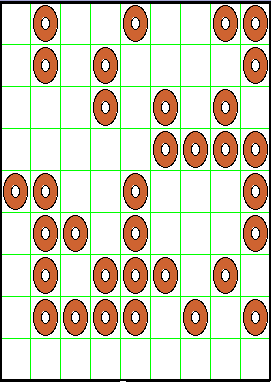 |
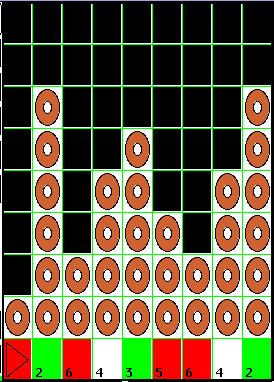 |
Your task is to write the methods that will
make the
In addition to their specificaitons,
all the methods described below must also meet
the following invariant:
Harvester buggle do its job. You are free to
write any auxiliary methods needed. At a minimum, you must
define the following methods for the Harvester class.
The complete specifications for each method are given in
HarvestWorld.java
(as usual, you can download the program files from the download
directory). Each method must satisfy the specification in the
code file. The descriptions below are intended to supplement and
clarify the specifications in the code file.
The buggle's state (position, heading, color, and brush state) will
not be changed by execution of this method. Assumes the buggle's
brush is initially up.
public intharvestField()
This method assumes that the buggle is starting in the lower left corner of a field facing EAST. When this method is invoked, the buggle will harvest the field of bagels to its front and left (up to the walls in front of and to the left of the buggle) and return the number of bagels harvested in this field.
public intharvestRow()
When this method is invoked, the buggle will harvest the row of bagels to its left (i.e. the vertical column above the buggle). The number of bagels harvested in this row is returned. This method should be invoked when the buggle is facing EAST and in the bottom row (the clear path) of the field.
public intharvestBagels()
When this method is invoked, the buggle will pick up all the bagels between it and the wall and return the number of bagels picked up. This method should be invoked when the buggle is facing NORTH and in the bottom row (the clear path) of the field.
public voidstackBagels(intnumberBagels)
When this method is invoked, the buggle will create a stack of the specified number of bagels in front of itself. This method assumes that there will always be at least enough space in front of the buggle for the bagel stack. This method should be invoked when the buggle is facing NORTH and in the bottom row (the clear path) of the field.
public intpullTarp()
When this method is invoked, the buggle should draw a black line from the wall in front of the buggle to the current cell in front of the buggle (i.e. do not color the cell the buggle is on when the method is invoked). This method returns the number of cells colored. This method should be invoked when the buggle is facing NORTH and at the end of its bagel stack (i.e. right where the tarp should start).
public voidmarkRow(intnumberBagels,intnumberSpaces)
This method paints the current cell green if numberBagels is greater than numberSpaces. The current cell is painted red if numberBagels is less than numberSpaces. The current cell is not painted if the numberBagels is equal to numberSpaces. The buggle also marks the cell with the numberSpaces (using dropInt());
Notes:
Use paintCell to color cells:
public void paintCell (Color c)
Paints the cell under this buggle with the color
c
Use dropInt to drop an integer
into a particular cell:
public int dropInt (int n)
Drops the integer n into the current cell and
returns the integer dropped.
Test your methods by executing the HarvestWorld.html applet. When you first load the applet, the BuggleWorld grid is empty. Hit Reset to generate a bagel field. Every time you Run this applet, the number of bagels reported by the Harvester buggle will appear in the cyan box within the parameter frame window.
A working applet can be found in the test subfolder of the HarvestWorld folder. You should experiment with this test applet to better understand the behavior of Harvester buggles.
Hint: It may be easier to write the methods in the reverse order from the order listed above. That is, you might want to start by writing the markRow() method.
Before starting this problem, you should read over the notes on the PathfinderWorld example.
Maisy Buggle comes from a long line of maze-navigating buggles. But unlike other buggles, she is not satisifed with stopping when she finds the first bagel in a maze. She wants to explore the world and find out how many bagels there are in the entire maze! For instance, suppose Maisy starts at "home" (facing eastward at point (1,1)) in the following maze:

Using the same maze-navigating strategy followed by the PathFinder buggle described in the the PathfinderWorld notes, Maisy can traverse the entire maze and determine that it contains 17 bagels. Suppose that, after exploring the submaze accessible from a given cell, Maisy writes in the cell the number of bagels in that submaze. Then after she returns to her home position, the maze would be annotated as follows.
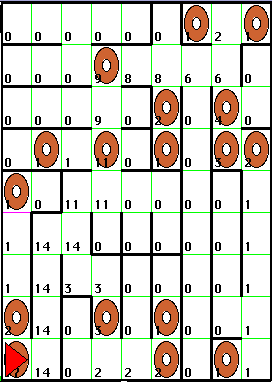
Note that the number in each cell is the number of bagels to the left, right, in front of, and under Maisy when she is in a cell (assuming she is facing the direction in which she entered the cell).
To get a better sense for how the above numbers are generated, you
should experiment with the test applet MazeCounterWorld.html within
the Test subfolder of the MazeCounter folder of ps6_programs_extra.
This applet has a parameter window that look like this:
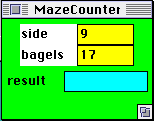
The numbers in yellow control the side length of the maze and the number of bagels placed randomly in the maze. If you change these and press the Reset button, a new maze will be created with these parameters. The cyan-colored box labelled result is where Maisy writes the total number of bagels in the maze when she returns home. For example, after Maisy has explored the maze depicted above, the parameter window changes to:
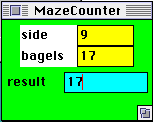
Before proceeding with this problem, you should play with the test applet and study the above pictures until you understand how the numbers for each cell are determined.
Maisy is a member of the MazeCounter class of buggles. Your goal
in this problem is to define a collection of methods in the
MazeCounter class that direct Maisy to count the number of bagels in
any maze, also annotating the cells with numbers, as shown above. You
should flesh out the skeleton of the MazeCounter class in the
MazeCounter folder of ps6_programs_extra. This skeleton contains a "stub"
version of a method with the following contract.
public int countBagels()
Counts the number of bagels to the left, right, in front of, and under this buggle.Drops this number in the cell under this buggle, and then returns it.Leaves the state of this buggle unchanged.
You should replace the stub with a method that works. As part of your solution, you should define any auxiliary methods that you find helpful. It is strongly recommended that you use a decomposition similar to the one used in for the PathFinder buggle. Your solution should work for any maze size and any number of bagels. (Warning: do not attempt to place more bagels in the maze than there are grid cells. This situation is not handled gracefully, and will cause your machine to crash.)
In order to drop an integer in a cell, you will need to invoke the following Buggle primitive:
public int dropInt (int n)
"Drops" the integer n in the cell of this buggle. The cell shows the most recently dropped integer. This method returns the integer that was dropped.
In this problem, your job is to use recursion to draw diamond-based pictures in TurtleWorld, as shown below. The diamonds are just squares turned on end at a 45-degree angle.
|
| |||||
|
| |||||
|
|
| ||||
|
|
| ||||
|
|
|
|
|
|
|
|
diamonds = 8 |
diamonds = 5 |
diamonds = 4 |
diamonds = 3 |
diamonds = 2 |
diamonds = 1 |
Diana is a DiamondMaker, a special breed of turtles that draw these kinds of patterns based on the side length of the largest diamond. Her initial position is at the bottom corner of the largest diamond in each picture; her initial heading is east. The diamond touching the largest diamond to the right has 2/3 the side length of the largest diamond. The diamond touching the largest diamond to the left has 1/3 the side length of the largest diamond. This pattern is repeated for each new diamond drawn. The new diamond on the right is now viewed in a new orientation where the top of the new diamond is 90 degrees in a clockwise direction from the larger diamond it touches. Therefore, the "right" of this new diamond points "south" and the left of this new diamond points "north". The new diamond on the left is now viewed in a new orientation where the top of this new diamond is 90 degrees in a counterclockwise direction from the larger diamond it touches. Therefore, the "right" of this new diamond points to the "north" and the "left" of this new diamond points to the "south". Each new diamond repeats the pattern of drawing a smaller diamond on its right and a smaller diamond on its left, if possible.
Unlike other recursive turtles we have studied, Diana draws a pattern whose depth of recursion is not controlled by an explicit levels parameter. Instead, it is controlled by the fact that Diana refuses to draw any line that is less than 5 units long. For instance, in the picture where the largest diamond has a side length of 9, Diana draws the smaller easterly diamond because its side length is (2/3)*9 = 6, which is greater than 5, but she does not draw the westerly diamond because its side length would be (1/3)*9 = 3, which is less than 5.
In addition to drawing the diamonds, Diana keeps track of the total number of diamonds she has drawn in the pattern. This number is indicated for each of the sample pictures above.
Your task in this problem is to implement the following instance method in the DiamondMaker class:
public int diamonds (double side)
Draws the recursive diamond pattern described above where the side length of the largest diamond is side. Returns the number of diamonds drawn. Draws no diamond whose side length is less than 5 units long. This method meets the invariant that the turtle's state (position, heading, color, pen state) is not changed by execution of the method.
Notes:
triQuilt(black,cyan,1) |
triQuilt(black,cyan,2) |
triQuilt(black,cyan,3) |
triQuilt(black,cyan,4) |
Your goal in this pattern is to define a triQuilt method
that creates the above pictures for any given colors and levels:
To complete this problem, flesh out the skeleton of thepublic Picture triQuilt (Color c1, Color c2, int n); Assume that n >= 1. Returns one of Gilda's quilts that is constructed out of triangles filled with colorsc1andc2. The parameter n controls the nesting level of the patterns used in the quilt.
triQuilt method in the TriQuiltWorld.java
file within the TriQuilt folder in
ps6_programs_extra. You will need to define several
auxiliary methods as well. Study the patterns in the example quilts
above carefully to determine what auxiliary methods you need.
We have seen that fascinating recursive patterns can be created in BuggleWorld, TurtleWorld, and PictureWorld. In this problem, we ask you to create your own recursive patterns in one or more of these worlds.
Start with the folders MyBuggleWorld,
MyTurtleWorld, and
MyPictureWorld in the
ps6_problems_extra folder.
Feel free to define any methods you desire to create
your patterns.
Some notes: